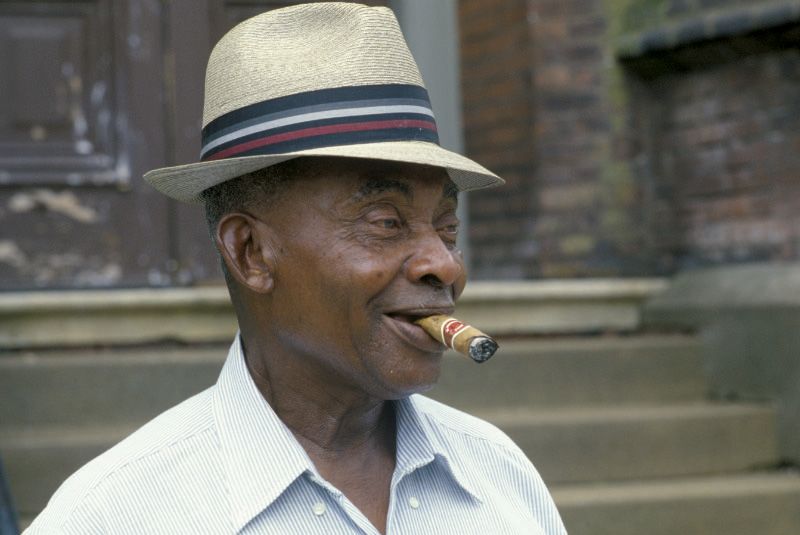Mississippi’s Redistricting Battles Shift to Grassroots – Mirror Trends Across the South
An African American man smoking a cigar, Vicksburg, Mississippi. (Joseph Sohm/Shutterstock)
Mississippi’s GOP dominated legislature secured gerrymandered maps that severely undercut the voting power of the state’s growing communities of color. But advocates have shifted their sights to local targets like the Harrison County School District and the Gulfport City Council. And they’re scoring small but significant victories. “We’re anything but a lost cause,” says Nsombi Lambright of One Voice. Mississippi mirrors similar efforts by activists across the South.
At an Ethnic Media Services briefing, Aug. 12, co-hosts One Voice, a leading non-profit civic engagement organization in Mississippi, the Legal Defense Fund of the NAACP, and the Southern Coalition for Social Justice based in North Carolina, focused on Mississippi, the birthplace of the civil rights movement, where community activists are taking the redistricting fight for fair representation to local school boards and city councils after the GOP-dominated legislature approved gerrymandering, gerrymandered maps for state and congressional districts.

These local efforts are scoring small but impressive gains and mirror a growing activism around redistricting at the local level in other southern states where gerrymandered maps have severely undercut voters of color in state and congressional elections.
Speakers – Nsombi Lambright, Executive Director, One Voice; Monica McInnis, One Voice; Pastor Jose Rodriguez, One Voice; Gary Fredericks, President, Gulfport NAACP; Amir Badat, Attorney, NAACP Legal Defense Fund; and Daniel Q. Le, Director, Boat People SOS – debated the Mississippi gerrymandering.
Amir Badat attorney with the Legal Defense Fund updated on the status of redistricting in Mississippi and the shift of focus to the grassroots.
“Mississippi is the is home to the largest proportion of black citizens in the country. In the late 1800s, after the Civil War, the white supremacists in Mississippi started the Mississippi plan of intimidation, violence, and a plan that used legal tactics to try to suppress the black vote and black civic participation during reconstruction, and the Mississippi plan including the 1890 Mississippi constitution was used by states like South Carolina, Alabama, Louisiana, other states across the south, to help suppress black civic participation and black progress across the country.
“We’re seeing the same things happening today. The fight over abortion, the Supreme Court overrule of ‘Roe vs Wade’ came out of Mississippi.
“Redistricting in Mississippi got its start with the Census in the middle of last year. In 2021 Mississippi’s legislature, which is responsible for redrawing its maps, put together a committee of legislators dominated by Republican legislators who are responsible for proposing maps to the full legislature for the full legislature’s adoption. That committee met three times in public for a total of 45 minutes. They convened the committee, appointed its members, adopted criteria, and adopted maps, so a lot of the work that went into producing these maps, happened behind closed doors without the involvement of Mississippi’s black legislators.
“Predictably, the maps that came out of this process were very unfair and not representative of the state as a whole, the Congressional map included one district that was a black majority district that had a packed black voting age population, which meant that the surrounding Congressional districts lacked the black voting age population that would be required for black voters in those districts to have an opportunity to elect candidates of their choice.
“The same happened with the State Legislature. Though that process is now over, though both maps have been adopted by the legislature, and signed into law by the Governor, there are legal challenges that have already been fought in the courts and will likely continue to be fought in the courts against both of those maps.
“A lot of the advocates and legal community in Mississippi have shifted our attention to state, county, and local level redistricting that affect people’s day-to-day lives, the school board, city council, those are the entities that are making decisions that will impact your child’s education, whether or not a pothole on your road is fixed, or whether or not the garbage is being picked up on time, and those are the issues that have a huge impact on people’s lives. A lot of people don’t know that those entities are also subject to redistricting.
“We at Legal Defense Fund, along with our partners, One Voice, the NAACP, and various organizations in Mississippi have been very engaged at the local and county redistricting level. We’ve been able to score some important victories that have allowed black voters and other minority voters in these jurisdictions to have more of a say, and more of an impact in elections that are happening at the local and the county level,” said Badat.
Nsombi Lambright, director, and her colleague, Monica McInnis, from One Voice, spoke next.
“There’s a growing infrastructure of civil rights and social justice organizations that are working on civic engagement and other social justice issues in Mississippi. We have a long way to go but we’re fighting, and we are seeing a few victories.
“When we get people active, and we make sure that they have the tools and skills to participate effectively, that they can effectively impact social policy.
“The efforts around the school board in Harrison County School District was such a dramatic example of this energy, now focusing on the grassroots, we knew that we started working with folks in Harrison County, and folks all over the state during the Census, and our civic engagement process goes from voter registration, through voter engagement, through voter protection, and when Census time came around, that became part of our civic engagement work.
“We just always stay on the go and keep folks activated, whether it’s a school board election or Congress, every election is important and even when there’s not an election, citizens can still stay involved in the political process whether it’s through the Census or redistricting.
“Harrison County has been one of those places where citizens have continued to stay engaged in organizing work over the years,” said Lambright.
Monica McInnis spoke about her work from Clinton, Mississippi.
“We believe that registrant is most important on the local level. A lot of people focus on the Congressional and State level, but the most important part is on the local level. I live in the city of Clinton, Mississippi, it’s the 10th largest city in Mississippi, and a few miles outside of Jackson, Mississippi.
“For most of the communities in 2010, it was the first time that a lot of was getting involved in the process of reducing. Once the community was educated, they were ready to have their voice heard.
“During the 2010 redistricting cycle, the City of Flint presented a map to DoJ, that claimed that there was not enough growth or shift in the population. There was a significant growth in the City of Clinton, and the NAACP of Clinton organized around the communities and came together and held workshops, and they produced an attorney map that was drawn using segment support from One Voice and submitted that map to DoJ, on behalf of the City of Clinton.
“In 2012, the district rendition plan had to be resubmitted and showed that there was a minority district, and just recently, in the last election, we have our first African-American Alderman on the board,” said McInnis.
“Shelby County vs Holder was a Supreme Court decision decided in 2013. The issue in that case was whether Section 4 of the Voting Rights Act, which had a pre-clearance formula, a formula to decide whether or not certain states, that had a discriminatory history in the context of voting, should be subject to pre-clearance by the Department of Justice. Pre-Shelby County, the way the process worked was that any time a state that was covered by Section 5 of the Voting Rights Act enacted a new change in election laws, or enacted a new redistricting map, or had a polling place change, all of those changes had to go to the Department of Justice and the Department of Justice would do an evaluation based on data submitted by the state or the jurisdiction of whether or not that change had a discriminatory impact on minority voters, inside of that jurisdiction. If it did, then the Department of Justice would essentially say ‘law is not going to go into effect, try again,’ and if it didn’t have a discriminatory impact only then could the law go into effect,” explained Badat.
“That was kind of an ex-ante check on these jurisdictions that had a history of discrimination. Post Shelby County, where the court decided that process is unconstitutional. The court said and the reasoning was, ‘We’ve made a lot of progress since 1965, when Section 5 was enacted. Look at all the progress we’ve made on the race front. We don’t need this process anymore. We don’t need pre-clearance anymore. We can let these states do what they want,’ after that decision what we saw was it all within days states enacting discriminatory voter id laws, states enacting all sorts of discriminatory election laws that had a negative impact on the ability of black and minority voters to access the ballot. It’s also impacted redistricting,” said Badat.
The remaining speakers talked about challenges specific to their communities and ethnicities to end the conference.


